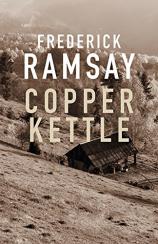Author Talk: February 9, 2017
Frederick Ramsay has authored mysteries set in Virginia (the Ike Schwartz Mysteries) and Botswana (PREDATORS, REAPERS), as well as a number of stand-alones. His latest, COPPER KETTLE, is set right after World War I and has war hero Jesse Sutherlin returning to his home a changed man. When a murder ignites an old family feud, Jesse must investigate before tensions come to a head. In this interview, Ramsay discusses his decision to go back in history with the Sutherlin family, who are featured prominently in his Ike Schwartz books. He also opens up about his research methods, how readers’ comments have affected his writing, and whether or not COPPER KETTLE will be expanded into its own series.
Question: You wrote a prequel to your Ike Schwartz series with COPPER KETTLE, setting it in 1920 shortly after the end of World War I, with returning soldier Jesse Sutherlin as the protagonist. What prompted that decision? And what kinds of research did you conduct to make the setting and period authentic?
Frederick Ramsay: The book might be said to be a prequel to BUFFALO MOUNTAIN, the third Ike Schwartz book. That book had its beginnings, its inspiration, if you will, from a comment made by my sixth grade social studies teacher, who wrote how much he liked the first two and mentioned he grew up in the area and I ought to read THE MAN WHO MOVED A MOUNTAIN. That book is a biography of the Rev. Bob Childress and his work in the mid-‘20s on the mountain. Anyway, I thought it might be fun to project one of the characters in the series back to an earlier time and place. Since there are a multiplicity of Sutherlins in the Ike books, their ancestors seem natural. Now I have to say that my grandfather came out of the mountain at about that time, so some of this could be said to be an homage to hill people in general. As to research, I returned to THE MAN WHO MOVED A MOUNTAIN for some of it, websites about WWI, McArthur sites, PTSD sites, and a vivid imagination (I make stuff up).
Q: You have Jesse functioning as an ad hoc detective in the story, which introduces a case of PTSD long before that term had been invented. Despite Jesse's reluctance to assume the role of detective, he does demonstrate a true talent for it. Might there be a follow-up period Jesse adventure set against the backdrop of Buffalo Mountain?
FR: I am of two minds regarding a sequel/series with Jesse as the protagonist. If modesty permits, I think this book is as good as it gets as far as my poor skills go. I am not sure I can meet that standard with another one. On the other hand, Jesse is “a man of the century,” and as such, it might be fun to walk him forward through the years, skipping ahead eight or 10 years at a time and brushing by the major events of the 20th century --- the Great Depression, World War II, moon walks, etc. Whether I do that will depend on how I feel after the book is out for a while.
Q: No doubt you often receive feedback from your readers as your series develops from book to book. Have you ever been struck by a comment to the extent that you incorporated the idea into a subsequent book?
FR: I can’t say that I have. I have shifted emphasis here and there. For example: People love the banter between Ike and Ruth, and I have made a point of increasing that.
Q: Is there one author in the crime fiction field whose work you particularly enjoy reading? And could you explain why that is?
FR: In my early years, I read all of John D. MacDonald’s Travis McGee books (and many of his others, as well). I think that had an influence on how I thought about Ike. He’s a sort of Semitic Travis. I am fond of Agatha Christie and think I have pretty much exhausted that canon. And Dashiell Hammett. Am I dating myself?




